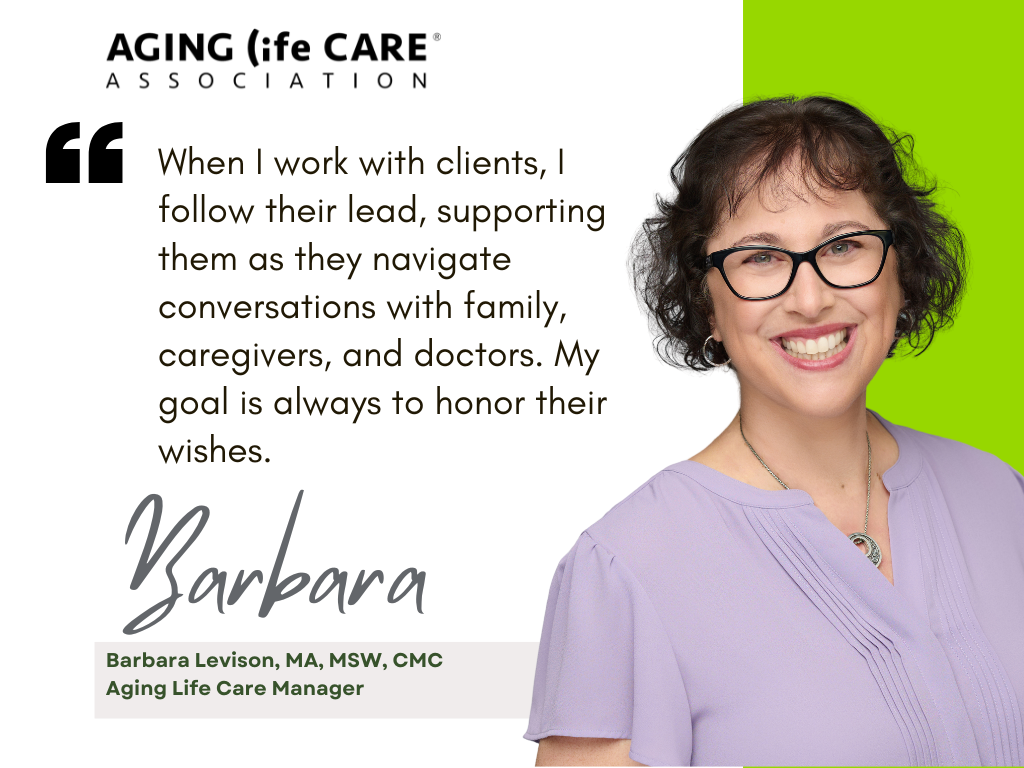Written by Barbara Levison, MA, MSW, CMC, Aging Life Care Manager
Being There: Advocating for Comfort and Dignity at the End of Life
When it’s time to choose hospice care for a loved one, families are often focused on one thing: reducing suffering and pain. For long distance caregivers, this can be especially difficult, worrying that the person they love might be in distress without anyone nearby to help.
As an Aging Life Care Professional, I often serve as an advocate for my clients when they transition into hospice care. One common misconception is that hospice provides 24/7 in home care. While hospice agencies do offer access to 24/7 support, someone must be present to recognize when help is needed and call for it. Hospice care can be provided at home, in assisted living, or in long term care settings, but families often need guidance to understand how it works in practice.
End of life care looks different for every person. Some individuals prefer not to talk about what their final days might look like, and that choice is valid. Others meticulously plan and communicate their wishes. Most people fall somewhere in between.
When I work with clients, I follow their lead, supporting them as they navigate conversations with family, caregivers, and doctors. My goal is always to honor their wishes.

Hospice adds a specialized layer of care to the existing team. A hospice nurse evaluates the client and collaborates with the hospice doctor to create a plan of care. Caregivers visit briefly to assist with personal care. Social workers offer emotional support, and chaplains provide spiritual care. Some agencies even offer music therapy, which can be deeply meaningful.
My role as an Aging Life Care Professional often includes serving as a liaison, connecting the hospice team with the client, their family, and private or facility, based caregivers. By the time a client enters hospice, I often have a long-standing relationship with them. I know their values, preferences, and routines, and I can share this information to help the team care for them in the most personalized way. I’m also able to recognize subtle signs of discomfort and work with the hospice team to address them.
It’s a privilege to walk alongside people during their final days. I’d like to share two personal stories that reflect the depth of this work.
The first is about a client I had grown very close to. She didn’t have children, and her husband had passed away suddenly less than a year earlier. Though she had family who lived far away, she had a small circle of trusted caregivers, and she knew her husband had trusted me.
In her final months, she lived in a memory care facility. When she entered hospice, I worked closely with the hospice nurse and facility staff to ensure she was comfortable. I visited every day, brought in her favorite music, arranged for a priest to administer last rites, and made sure friends and family had a chance to say goodbye. I held the phone to her ear so her distant relatives could speak to her.
One morning, I arrived as usual. My client was resting peacefully. A new caregiver was with her, and I spent a few minutes telling her about the incredible woman she was, a smart, compassionate doctor who had been one of just four women in her medical school class of 100. As I leaned towards the bed to say goodbye, I realized she had quietly passed while I was speaking. Her family found comfort knowing she died peacefully, with someone who truly cared for her nearby.
The second story is closer to home. My mother-in-law was admitted into hospice care at a local memory care facility. The last time I saw her open her eyes, the day before her admission, she smiled and winked at me.
I visited daily and worked closely with the staff and hospice nurse. One afternoon, my daughters and niece joined me to visit her. My daughter, a music therapist, brought her guitar, and together they sang Hebrew songs, songs that held deep meaning for their grandmother. Although her eyes remained closed, she hummed softly and tapped her fingers. Hospice sent their Rabbi, who gathered our family and led a deeply moving reflection on her life. We knew she was listening. She passed away peacefully, surrounded by love.
Many people have never witnessed the end-of-life process. Even though I have supported many clients and family members through this time, each experience is unique. Every person deserves to be seen as a whole person, honored for who they are, what they value, and the life they’ve lived.
At the end of life, my goal is simple: to bring peace, dignity, and personalized care. It is an honor I never take for granted.
About the Author:
Barbara Levison, MA, MSW, CMC is an Aging Life Care Manager® with nearly 30 years of experience supporting older adults and their families. A Certified Care Manager since 2007, she has provided care management services with Proeger & Associates since 1997. Barbara serves on the Board of Directors for the Aging Life Care Association® and holds the Fellow of the Leadership Academy designation, recognizing her as an advanced practitioner and leader in the field.